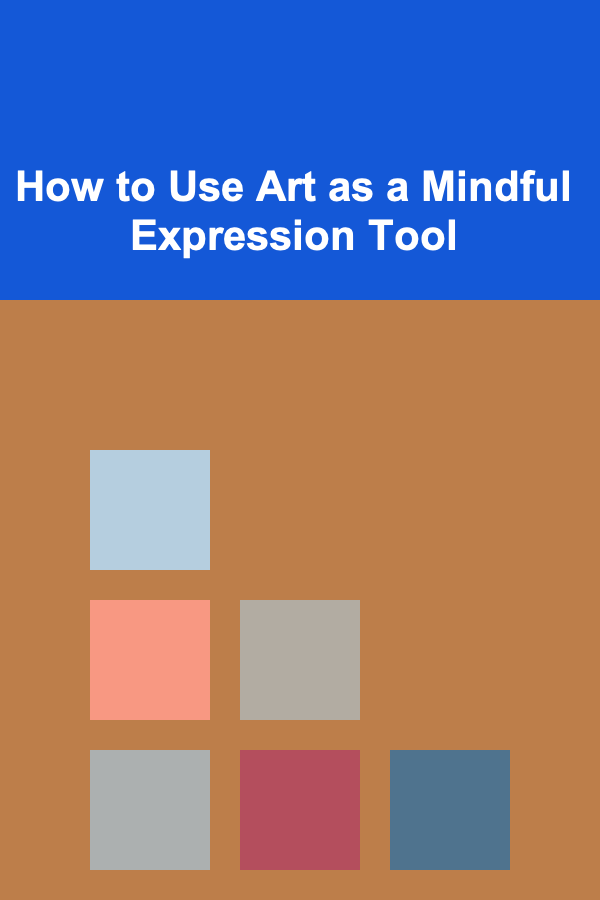
How to Use Art as a Mindful Expression Tool
ebook include PDF & Audio bundle (Micro Guide)
$12.99$8.99
Limited Time Offer! Order within the next:

In a world increasingly characterized by rapid change, high stress, and constant distraction, finding ways to cultivate mindfulness has become essential for mental well-being. One powerful method of achieving mindfulness is through art. Artistic expression not only allows individuals to communicate their thoughts and emotions but also serves as a profound tool for self-reflection and personal growth. This article explores how art can be utilized as a mindful expression tool, delving into its benefits, different forms of artistic expression, and practical techniques for integrating art into mindfulness practices.
Understanding Mindfulness
1.1 What is Mindfulness?
Mindfulness is the practice of being present and fully engaged in the current moment, without judgment. It involves focusing on one's thoughts, feelings, and sensations as they occur, cultivating an awareness that can lead to greater emotional regulation and resilience. Mindfulness encourages individuals to observe their experiences with curiosity rather than react impulsively, allowing for deeper insights into their inner lives.
1.2 The Connection Between Mindfulness and Art
Art provides a unique avenue for mindfulness as it engages both the mind and body in the creative process. When creating or experiencing art, individuals are often drawn into a state of flow---a heightened state of consciousness where time seems to stand still. This state facilitates deep concentration, making art an excellent vehicle for practicing mindfulness.
By leveraging artistic expression, individuals can slow down, become aware of their emotions, and express thoughts that may otherwise remain unarticulated. Moreover, art serves as a non-verbal language, enabling people to convey complex feelings and experiences that may be difficult to communicate in words.
The Benefits of Art as a Mindful Expression Tool
2.1 Emotional Release
Engaging in artistic activities can serve as a powerful emotional outlet. Art allows individuals to express feelings such as joy, sadness, anger, or frustration in a constructive manner. This release can lead to catharsis, helping to alleviate emotional burdens and promote healing. By externalizing emotions through art, individuals can gain clarity and perspective, transforming overwhelming feelings into tangible expressions.
2.2 Enhanced Self-Awareness
Art encourages self-exploration and reflection. Through the creative process, individuals are prompted to examine their thoughts and emotions, fostering greater self-awareness. This introspective journey enables individuals to identify patterns in their behavior and feelings, leading to personal insights and growth. The act of creating art can illuminate aspects of oneself that may have been previously unnoticed, enriching one's understanding of their inner world.
2.3 Stress Reduction
Creative expression is an effective way to reduce stress and anxiety. When individuals engage in artistic activities, they often enter a meditative state, allowing them to escape from daily pressures and concerns. Art has been shown to lower cortisol levels---the hormone associated with stress---thereby promoting relaxation and a sense of well-being. Additionally, creating art can release endorphins, further enhancing mood and reducing feelings of anxiety.
2.4 Cognitive Flexibility
Art fosters cognitive flexibility, encouraging individuals to view situations from multiple perspectives. The creative process often involves experimentation, problem-solving, and adaptation, which can translate to greater resilience in everyday life. Engaging in art can help individuals cultivate a mindset that embraces change and uncertainty, ultimately enhancing their ability to cope with challenges.
Different Forms of Artistic Expression
3.1 Visual Arts
Visual arts encompass a wide range of mediums, including painting, drawing, sculpture, and photography. These forms allow individuals to explore their creativity and express emotions visually. Techniques such as abstract painting or sketching can provide immediate, non-verbal outlets for feelings, facilitating mindfulness through visual engagement.
3.2 Music
Music is a powerful form of artistic expression that can evoke profound emotional responses. Whether playing an instrument, singing, or listening to music, individuals can tap into their feelings and experiences through sound. Engaging with music mindfully---focusing on melodies, rhythms, and lyrics---can enhance emotional processing and promote relaxation.
3.3 Dance and Movement
Dance and movement are dynamic forms of expression that connect the body and mind. Engaging in dance can serve as a physical release for emotions, allowing individuals to experience and express feelings through movement. Mindful dancing emphasizes awareness of body sensations, rhythms, and emotions, fostering a deeper connection between the self and the present moment.
3.4 Writing
Writing, whether in the form of poetry, journaling, or storytelling, offers a way to articulate thoughts and feelings. Creative writing can be a therapeutic exercise, helping individuals process experiences and emotions. Engaging in mindful writing encourages individuals to focus on their thoughts, allowing for exploration and reflection.
Practical Techniques for Using Art in Mindfulness
4.1 Setting the Stage
Creating an environment conducive to mindful art-making is essential. Here are some tips for setting the stage:
- Choose a Dedicated Space: Find a quiet, comfortable area free from distractions where you can focus on your art.
- Gather Supplies: Collect all necessary materials (paints, brushes, paper, etc.) to avoid interruptions during the creative process.
- Create a Relaxing Atmosphere: Consider lighting candles, playing soft music, or incorporating elements that inspire calmness and creativity.
4.2 Engaging the Senses
Mindfulness in art involves engaging the senses fully. Here are some techniques to incorporate sensory awareness into your practice:
- Focus on Colors: Pay attention to the colors you choose and how they make you feel. Notice the vibrancy, texture, and interplay of colors on the canvas.
- Listen to Sounds: If you're listening to music while creating, focus on the different instruments, rhythms, and melodies.
- Feel the Materials: Take time to explore the textures of your art supplies. Notice the smoothness of paint, the roughness of paper, or the weight of a brush in your hand.
4.3 Journaling and Creative Writing
Journaling can be a powerful form of mindful expression. Try these techniques:
- Stream of Consciousness Writing: Set a timer for 10-15 minutes and write continuously without worrying about grammar or punctuation. Let your thoughts flow freely onto the page.
- Prompt-Based Writing: Use prompts such as "What brings me joy?" or "Describe a recent challenge." Reflect on your responses and explore your feelings.
- Gratitude Journaling: Write down things you are grateful for, focusing on the details and feelings associated with each item. This practice can shift your mindset toward positivity.
4.4 Guided Art Activities
Participating in guided art activities can provide structure and inspiration. Some ideas include:
- Art Therapy Workshops: Explore local art therapy programs that provide guidance and support for using art as a therapeutic tool.
- Online Art Classes: There are numerous online platforms offering courses in various art forms. Look for classes that emphasize mindfulness and self-exploration.
- Collaborative Art Projects: Engage with others in creating art together. Group projects can foster connection and shared expression.
Creating a Personal Mindful Art Practice
5.1 Finding Your Medium
Exploring different art forms can help you discover what resonates most with you. Consider trying:
- Painting: Experiment with watercolors, acrylics, or oils to express your emotions through color and form.
- Drawing: Use pencils, charcoal, or pastels to capture moments or feelings in a more intimate way.
- Digital Art: If you enjoy technology, consider exploring digital art tools and applications for creative expression.
5.2 Establishing a Routine
Integrating art into your regular routine can enhance its impact on mindfulness. Consider:
- Setting Aside Time: Dedicate specific time blocks each week for artistic expression. Treat these sessions as sacred, uninterrupted moments for yourself.
- Creating Rituals: Develop rituals around your art practice, such as lighting a candle, playing specific music, or using particular materials to signal the beginning of your creative time.
5.3 Reflecting on Your Process
After engaging in artistic expression, take time to reflect on your experience. Consider journaling about:
- Your Feelings: What emotions arose during the creative process? How did you feel afterward?
- Your Insights: Did you learn anything new about yourself? Were there any breakthroughs or realizations?
- Your Growth: How has engaging with art contributed to your overall well-being and mindfulness practice?
Case Studies and Personal Stories
Personal Story: A Journey Through Painting
Sarah, a busy professional, found herself overwhelmed by the demands of her job and personal life. Seeking a way to reconnect with herself, she turned to painting. Initially hesitant, Sarah attended a local art class that emphasized mindfulness in creativity. Through this experience, she learned to express her emotions on canvas, using colors and shapes to represent her feelings.
As Sarah painted, she began to experience a sense of calm, losing herself in the process. Each brushstroke became a meditation, allowing her to release stress and anxiety. Over time, Sarah developed a routine of painting every Sunday afternoon, reflecting on her emotions and experiences as she created. This practice not only brought her joy but also enhanced her self-awareness and emotional resilience.
Case Study: Art Therapy in Mental Health
A study conducted with participants undergoing art therapy demonstrated significant improvements in emotional well-being. Participants reported reduced anxiety and depression levels after engaging in guided artistic expression. The therapists noted that creating art allowed individuals to process trauma and express complex emotions.
Participants in the study were encouraged to explore various mediums, fostering creativity and self-expression. The results highlighted the transformative power of art in promoting mindfulness and emotional healing, reinforcing the idea that artistic expression can be a vital component of mental health treatment.
Conclusion
Art serves as a powerful tool for mindful expression, providing individuals with a means to explore and articulate their innermost feelings and thoughts. By engaging in various forms of artistic expression, individuals can cultivate mindfulness, enhance self-awareness, and promote emotional well-being. Whether through visual arts, music, dance, or writing, the act of creating can lead to profound insights and healing.
Integrating art into daily life does not require prior experience or talent; it simply requires an open heart and mind. As you embark on your journey of mindful expression through art, remember to embrace the process, honor your emotions, and allow creativity to guide you. By doing so, you will not only enrich your own life but also discover the transformative power of art as a pathway to mindfulness and self-discovery.
Reading More From Our Other Websites
- [Home Staging 101] How to Stage Your Home's Basement to Appeal to Buyers
- [Personal Care Tips 101] How to Use a Razor with Shaving Cream for the Smoothest Results
- [Home Holiday Decoration 101] How to Use Scented Candles to Enhance Your Holiday Ambiance
- [Organization Tip 101] How to Use Tags and Labels for Better File Retrieval
- [Home Storage Solution 101] How to Maximize Bathroom Storage Without Compromising Style
- [Organization Tip 101] How to Use Affirmations in Your Decor for Positive Energy
- [Biking 101] 10 Essential Cycling Tips for Beginners
- [Home Lighting 101] How to Update Your Lighting Fixtures for a Fresh Look
- [Small Business 101] Small Business Insurance Quotes: Understanding What's Included in Your Policy
- [Gardening 101] Essential Tips for Maintaining and Repairing Your Garden Fence

How to Build a Checklist for Implementing Accessibility Testing Tools on Your Website
Read More
How to Host a Family Talent Competition at Home
Read More
How to Use a Dry Erase Board for Daily To-Do Lists
Read More
How To Understand the Impact of Quantum Biology in Medicine
Read More
How To Craft Irresistible Marketing Messages
Read More
How to Design a Weightlifting To-Do List for Powerlifting Specificity
Read MoreOther Products

How to Build a Checklist for Implementing Accessibility Testing Tools on Your Website
Read More
How to Host a Family Talent Competition at Home
Read More
How to Use a Dry Erase Board for Daily To-Do Lists
Read More
How To Understand the Impact of Quantum Biology in Medicine
Read More
How To Craft Irresistible Marketing Messages
Read More